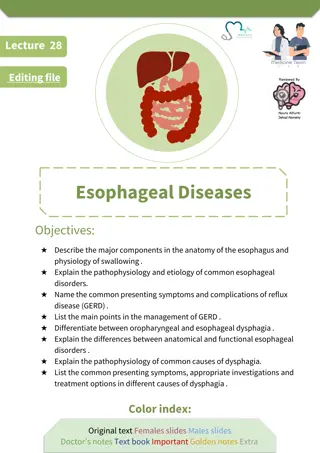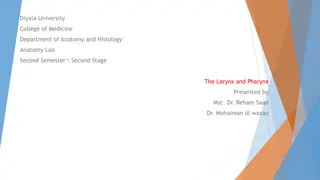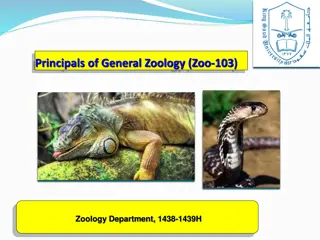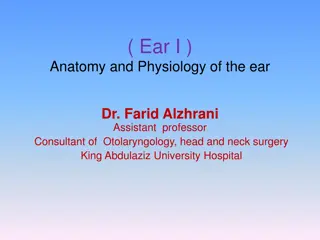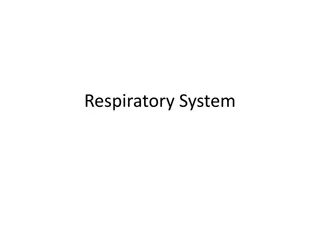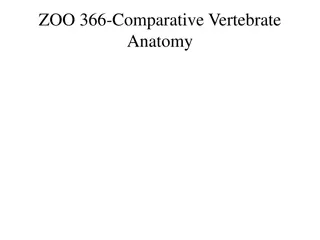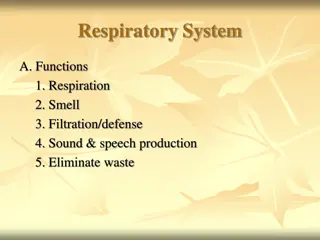Pharynx Anatomy and Physiology Overview
Pharynx serves as a crucial space connecting respiratory and digestive systems, divided into nasopharynx, oropharynx, and laryngopharynx. It houses important structures like mucous membrane, submucosa, muscular layers, and neurovasculature. Understanding pharynx anatomy is essential for diagnosing and managing various conditions affecting this region.
Download Presentation

Please find below an Image/Link to download the presentation.
The content on the website is provided AS IS for your information and personal use only. It may not be sold, licensed, or shared on other websites without obtaining consent from the author.If you encounter any issues during the download, it is possible that the publisher has removed the file from their server.
You are allowed to download the files provided on this website for personal or commercial use, subject to the condition that they are used lawfully. All files are the property of their respective owners.
The content on the website is provided AS IS for your information and personal use only. It may not be sold, licensed, or shared on other websites without obtaining consent from the author.
E N D
Presentation Transcript
Pharynx I-II Objectives: Pharynx I -anatomy of the pharynx and deep neck spaces (retro and parapharyngeal) -physiology (function of pharynx in brief) - acute and chronic pharyngitis (non-specific and specific) e.g scarlet fever, infectious moniliasis. -Zenker diverticulation (in brief) Pharynx II -adenoid and tonsil diseases. -complication of pharyngeal diseases -adenotonsillectomy (indications, complication and management). -DDx of Membranous tonsil Resources: Doctor s slides, 436 Team Done by: Tareq Alluhidan, Khaled Alsmari Edited by: Revised by: Naif Almutairi [Color index: Important | Notes | Extra] 1
Anatomy of Pharynx and deep neck spaces The pharynx is a common space for the conductive pathways of the respiratory (gases) and digestive (food and drink) systems. As such, the pharynx shares borders with the nasal cavity (choanae), oral cavity (palatoglossal folds surrounding the facial isthmus), larynx (laryngeal inlet), and esophagus(entrance to esophagus ). The pharynx is divided into three regions : -Nasopharynx (choanae, soft palate) -Oropharynx (soft palate, palatoglossal arch, epiglottis & pharyngo-epiglottic folds) , -Laryngopharynx (epiglottis & pharyngo-epiglottic folds, inferior margin of cricoid cartliage). 1 - Nasopharynx (from the base of the skull till the soft palate) Opens anteriorly to the nose, Above: the base of skull Below: soft palate Laterally: Opening of the Eustachian tube Torus tubarius (the elevated edge of the Eustachian tube opening). very important to examine nasopharynx in smoker adult complaining of nasal obstruction because Its a common site for nasopharyngeal carcinoma. 2 - Oropharynx Opens anteriorly to the mouth and divided from the oral cavity by Tonsillar pillar . Above: soft palate . Below: the upper border of epiglottis . Palatine tonsils: between the anterior and posterior pillars - Laryngopharynx (Hypopharynx) From the epiglottis to the cricoid Opens anteriorly to the larynx Above: the upper border of the epiglottis Below: lower border of cricoid 3 Structures of Pharynx: 1 - Mucous membrane : Nasopharynx Ciliated columnar epithelium Oro and hypopharynx Stratified squamous epithelium Transitional epithelium 2 - Submucosa Nerves, blood vessels,and lymphatics . Mucous and salivary glands . Subepithelial lymphoid tissue (Waldeyer s Ring). Characteristics of Waldeyer s Ring: No afferents Efferent to deep cervical nodes No capsule except the palatine tonsils 2
- Muscle layer 3 The muscular wall of the pharynx consists of two layers : an outer layer (constrictors) and an inner layer (elevators) . *The three pharyngeal constrictor muscles: superior pharyngeal constrictor muscle middle pharyngeal constrictor muscle inferior pharyngeal constrictor muscle. (the largest) when we open the mouth we see the middle constrictor and little bit of the inferior, but not the superior because it s behind the nasopharynx The three inner (elevators) muscles : Stylopharyngeus M. (from styloid process) Palatopharyngeus M. (from the hard palate) Salpinogopharyngeus M (from eustachian tube) Salpinogopharyngeus and Palatopharyngeus muscles are important for the opening of eustachian tube, in cases of cleft palate these muscles are not functioning very well, so the patient will have problems in middle ear, like: OM with effusion and hearing loss. Neurovasculature : With the exception of the Stylopharyngeus muscle, the muscles of the pharynx are innervated by the pharyngeal (neural) plexus srebif )rotom( tnereffe seviecer hcihw , eht morfvagus nerve eht morf srebif )yrosnes( tnereffa dna glossopharyngeal nerve . dna )citehtapmysarap( evren sugav eht morf srebif cimonotua seviecer osla suxelp ehT )citehtapmys( noilgnag lacivrec roirepus . The stylopharyngeus muscle are innervated both efferently and afferently by the glossopharyngeal nerve (CN IX) . The muscles of the pharynx are predominantly supplied by the ascending pharyngeal artery, a branch of external carotid artery. They are drained of blood by the pharyngeal venous plexus, which drains into the internal jugular V . -The pharyngeal mucosa is afferently innervated by the pharyngeal plexus as well, with exception of the mucosa of the nasopharynx, which is afferently innervated by a branch of V 2 N lanimegirt eht fo noisivid yrallixam eht , . 3
Retropharyngeal Space: -Is a potential space posterior to the muscular wall of the pharynx (and its investing buccopharyngeal fascia), anterior to the prevertebral fascia, and spanning the distance between the base of the skull and the mediastinum (within the thoracic cavity). -The retropharyngeal space is actually comprised of two potential spaces, separated by the alar fascia : - - anterior, the true retropharyngeal space posteriorly, the danger space . -The RPS communicates laterally with the parapharyngeal spaces. Clinically, the retropharyngeal space is important, because it repersents a potential pathway for metastasis of disease between the head&neck and the thorax, specifically by means of the danger space xaroht eht fo munitsaidem roirepus htiw ecaps laegnyrahporter eht tcennoc nac hcihw . , Parapharyngeal space : -The PPS represents a triangular space bounded laterally by the masticator and parotid spaces, posteriorly by RPS, and Superiorly by the skull base . -The PPS contents are: ICA,IJV,fat, minor salivary glands, and rarely lymph nodes. Triangular in cross section, it extends from the base of the skull above to the sup mediastinum and apex of hyoid bone . Anteromedial wall: Buccopharyngeal fascia Posteromedial wall: Cervical vertebrae, prevertebral muscle and fascia Lateral wall: dnalg ditorap ,elcsum diogyretp ,elbidnam eht )pU( elcsum diotsamonretS )rewoL( Compartment: ( if the patient has tonsillitis and on examination there is bulge in lateral pharyngeal wall, on CT there is poststyloid abscess so I have to do incision and drainage since this is a dangerous area, they could have carotid rupture, cranial nerve paralysis) internal maxillary artery, fat, inferior alveolar, lingual, and auriculotemporal nerves. Prestyloid neurovascular bundle (carotid artery,, internal dangerous, because it has jugular vein, sympathetic chain ,CN IX,X and,XI). Postyloid 4 In parapharyngeal neck swelling, the neck mass is lateral. But if there is a mass in the retropharyngeal space, when the patient opens his mouth you ll see the mass in front of you.
Waldeyers Ring: )This ring is important for fighting infections) -It is formed by lymphatic tissue in pharynx and larynx: - Adenoid - in nasopharyngeal vault - Tubal Tonsils (Gerlachi) - in fossa rosenmulleri (the opening of eustachian tube) - Palatine Tonsils - between palatal arches, they are divided from pharyngeal muscles by fibrous capsule . - Lingual tonsils - on the base of the tongue - Lymphatic tissue in the pharyngeal wall - on the dorsal and lateral walls Physiology of Pharynx: Functions of the pharynx: Swallowing Immune response to infection Resonance chamber for modulating vocal sounds Respiration Speech Articulation Taste: taste buds Acute and chronic pharyngitis Acute :sesac suoitcefnI 1 - Viruses : Rhinovirus - commonest - spring & fall Coronavirus - winter Adenovirus - early summer - sever Herpes simplex virus (HSV) 1 and 2 Influenza A and B 60% - 40% Parainfluenza virus Epstein-Barr virus (EBV) Cytomegalovirus (CMV) Human herpesvirus (HHV) 6 HIV 5
INFECTIOUS MONONUCLEOSIS Pathogen: Epstein bar virus. Adolescents are especially susceptible (kissing disease). Transmission through oral contact Signs and Symptoms: High Fever Generalized Lymphadenopathy. (Tender) Malaise, fatigue Exudative tonsillitis . Hepatosplenomegaly. O/E etalap tfos Diagnosis: Paul bunnel test (Monospot test.) (heterophile antibodies in serum) 80% mononuclear and 10% atypical lymphocytes on smear. (Usually diagnosed clinically) no reclu dna eaihcetep ,)sitillisnot suonarbmem( enarbmeM a htiw slisnot eguH : Complication: Involvement of cranial nerves . Meningitis. Autoimmune hemolytic anemia. Splenic rupture (activity restriction may be necessary to prevent splenic rupture in patients with splenic enlargement). Treatment: Hydration, analgesia and oral hygiene. Avoid ampicillin causes maculopapular rash. (if the tonsils causing airway obstruction we can give steroids to reduce the edema) Acute and chronic pharyngitis Con.. Acute: 2 - Bacteria: GABHS Group C beta-hemolytic streptococci Neisseria gonorrhoeae Corynebacterium diphtheriae Mycoplasma pneumoniae chlamydophila pneumoniae fusobacterium necrophorum 6
Scarlet fever (Scarlatina) Etiology The rash of scarlet fever is caused by the streptococcal pyrogenic exotoxins (ie, SPE A, B, C, and F). )SHBAG( succocotperts citylomeh - yb yb decudorp nixotodnE : B A epyt Signs and symptoms: Red pharynx Strawberry tongue (glossitis)( Perioral skin erythema and desquamation Dysphagia Malaise Severe cervical lymphadenopathy. Diffuse erythematous rash Circumoral pallor Dx: Clinically, Rapid antigen test (strep test), throat culture Treatment: )cigrella fi sedilorcaM( nillicineP Acute and chronic pharyngitis Con.. Acute: 3 - Noninfectious causes: Persistent cough Postnasal drip Gastroesophageal reflux disease (GERD) Acute thyroiditis Neoplasm Allergies Smoking Chronic pharyngitis Pathogenesis : Functional disorders of mucosa, chronically acting exogenous agents. (smoking, allergies) It is more often in adults . Symptoms: -Dry pharyngeal mucosa or on the contrary erythema with secretion increase, usually without fever . -Thickness, swelling of pharyngeal mucosa with prominences of islets or strips of lymphatic tissue, production of secretion, which often irritates and forces cough (especially in the morning) ,sense of foregin body in throat. Dx :Clinically by examination DDxesaesiD nerg jS , sitignyrahp cificeps : 7 Treatment scitpesitna lacol ,noitalahni maetS ,sdiulf - citamotpmyS :
Zenker's diverticulum -is a hypopharyngeal pouch caused by herniation of all muscular layers through an area of weakness between the transverse fibers of the cricopharyngeal muscle and the oblique fibers of the lower inferior constrictor muscle, called Killian s dehiscence or triangle of Killian. -It is uncommon, but the most common type of esophageal diverticulum -Patients regularly present with symptoms of dysphagia, regurgitation, aspiration, chronic cough and weight loss. the diagnosis is more frequent in elderly males and has a peak incidence between the age of 70 and 90 . -Pathogenesis is due to a combination of increased hypopharyngeal pressure, brought forth during deglutition and dysfunction of the cricopharyngeal muscle. -The only known curative treatment for ZD is surgery by dividing the cricopharyngeal muscle either through a transoral(CO2 laser or stapler) approach or by open surgery (cervical cricopharyngeal myotomy) Signs and symptoms: Dysphagia Regurgitation of undigested food Aspiration Chronic Cough Weight loss DX wollaws muiraB : laser or Rx stapler) approach or by open surgery. 2 OC( larosnart a hguorht rehtie .ymotoym laegnyrahpocirC : Conclusion: -A wide variety of pathology can present with a sore throat -comprehensive history and clinical examination are essential -Referral is important to clarify diagnosis and further treatment End of First Lecture 8
Chronic adenotonsillar Hypertrophy (basically in young adults) Etiology : -most common indication for adenotonsillectomy -increased immunologic activity -loads of pathogenic bacteria, especially B- lactamase producers Airway obstruction : -obstructive sleep apnea is the most common indication for tonsillectomy in the paediatric population. -paediatric obstructive sleep apnea incidence of 1% to -worse in supine and asleep (gravity) and the relaxation of surrounding soft tissue . -snoring, apnea and oxygen desaturation. (apnea is pausing of breathing for more than 7 seconds in children, and more than 10 seconds in adults) 3% Symptoms : -Pulmonary hypertension and cor pulmonale, failure to thrive, and developmental delay. - Loud heroic breathing, diaphoresis, apnea, gasping, mouth-breathing, restless sleep,enuresis, drooling, night terrors, and sleepwalking . -Daytime sleepiness, morning headache, dry mouth, halitosis, swallowing difficulty, behavioural difficulties and hyponasal speech . -Hyperactivity, inattentiveness in the classroom, problems with academic performance, and rebellious or aggressive behaviour. attention deficit Hyperactivity disorder (ADHD). Witnessed apnea: One episode of apnea in one hour of sleep in children or 3 - 5 episodes in adults . 9
Recurrent adenotonsillitis Etiology: Anaerobic BLPO. bacterial, of these 39% are beta lactamase-producing(BLPO). % 30 - 5 GABHS (Group A Beta-Hemolytic Streptococci) most important pathogen because of potential sequelae. Dx erutluc taorhT : . Rx SHBAG rof evitagen si erutluc taorht fi neve ,enil tsrif si nillicineP : . -For acute UAO: NP airway, steroids, IV abx,and immediate tonsillectomy for poor response . Paradise criteria: The commonest and absolute indication of tonsillectomy is the enlargement causing OSA. The recurrent adenotonsillitis is a relative indication, so it is not a must . 1 0
Unilateral tonsillar enlargement : Apparent enlargement vs true enlargement Non-neoplastic : Acute infective chronic invective Hypertrophy congenital -While examining the child, when you put the tongue depressor he will squeeze to counteract the tongue depressor so the lateral wall will come medially that will show like if the tonsil is big, so you have to make sure it is true enlargement of one side of tonsil. in children usually it is because of infection or congenital. in adults, it is a red flag, think of malignancy, do biopsy by tonsillectomy (both sides) to rule out lymphoma (commonest) or SCC. Neoplastic Peritonsillar abscess (quinsy) -An abscess between the tonsil capsule and the adjacent lateral pharyngeal wall . -common in patients with recurrent tonsillitis or in those with chronic tonsillitis that has been inadequately treated. -Pus formation between the tonsil bed and the tonsillar capsule. -Unilateral and the pain is severe, with referred otalgia to the ipsilateral ear a few days after the onset of tonsillitis -Drooling is caused by odynophagia and dysphagia. Trismus is frequently present. symptoms: Fever Otalgia Odynophagia Uvular deviation. Trismus Drooling of saliva Hot potato voice On one side Complications: Para and retropharyngeal abscess Aspiration pneumonia Dxnoitcefni laiborcimylop a wohs serutluc : Rx: needle aspiration followed by incision and drainage if there has been a previous history of tonsillitis, a Quinsy tonsillectomy may be quite effective when there is extension of infection of the peritonsillar abscess, CT with contrast may be indicated 1 1 *IV ABx
Parapharyngeal abscess Source of the infection: ssecsba rallisnotirep morf ro slisnot rehtie morf sniard sup elcsum rotcirtsnoc roirepus eht hguorhT . -The abscess is located between the superior constrictor muscle and the deep cervical fascia and causes displacement of the tonsil on the lateral pharyngeal wall toward the midline. -May spread to the mediastinum. Sign and symptoms : Pain Leukocytosis Trismus fever Neck mass muffled voices (hot potato voice) intraoral bulge (lateral) O/E: Swelling of the lateral pharyngeal wall, behined posterior tonsillar pillar. Neurologic deficits ( IX, X, and XII) Investigations : Laboratory and bacteriology CT (best modality) MRI Treatment : Aggressive IV ABX, fluid and close observation. Surgical intervention with external dedeen netfo si hcaorppa )eganiard LANRETXE( Airway management You have to mention all three Retropharyngeal abscess -Cranial base to the mediastinum, Unilateral -Lymph nodes receive drainage from the nose, paranasal sinuses, pharynx , and eustachian tube common in children younger than 2 years. -irritability, fever, dysphagia, muffled speech, noisy breathing, stiff neck, Odynophagia, and cervical lymphadenopathy.(stridor) pic: Thickness of prevertebral fascia, and sometimes you can see gas bubbles in the abscess -P/E . gnillews laegnyrahp roiretsop laretalinu : Dx: Lateral neck radiography, CTS/U ro Rx: A transoral approach is recommended for incision and drainage of abscesses . -if the abscess extends inferiorly below the hyoid bone, an external approach should be used. IV ABx Secure Airway 1 2 MENTION ALL 3 !
Adenotonsillectomy indications : - 3 or more episodes per year -malocclusion, UAO -Quinsy unresponsive to Rx (we do hot tonsillectomy for these patients) -Halitosis -Asymmetry, suspicious for malignancy -individual considerations complications: postoperative hemorrhage (most drastic), sore throat, otalgia, uvular swelling, respiratory compromise (in OSA patients they might get it immediately after surgery), dehydration, burns and iatrogenic trauma (during cauterization) , velopharyngeal insufficiency, nasopharyngeal stenosis, atlantoaxial subluxation, grisel s syndrome, regrowth (4% but can be 7% if: woleb egA 1 ACI fo mysruenaoduesp /ACI fo noitarecal ,noisserped ,yrujni ebut naihcatsuE , year - 1 cigrella ereveS - sitignyral xulfeR 3 - 2 )sitinihr adenoidectomy indications : - obstructions: 1 -chronic nasal obstruction or obligate mouth breathing -OSA with failure to thrive (FTT), cor pulmonale -dysphagia -speech problems -severe orofacial/dental abnormalities (Adenoid face: long nose, short upper lip) - infection : -Recurrent/chronic adenoiditis (3 or more episodes/year) -Recurrent / chronic OME (+/-previous BMT) (if you have a kid with recurrent OME, you do tubes in the first setting, after 1 year the tubes will come out then he will get the fluids back, in the second time in addition to putting the tubes you also need to remove the adenoid if he doesn t snore, if snoring, it should be removed with the tubes) 2 1 3
Primary hemorrhage: within the first 24 hours after surgery. Secondary hemorrhage: from 24 hours and beyond (10d for example). in primary hemorrhage if active bleeding you need to take the patient to the OR to control the bleeding, also do CBC and coagulation profile. in secondary or delayed hemorrhage they usually come after no active bleeding remove the clot and observe them, but if there is active bleeding take him to the OR to control it and do CBC and coagulation profile. 10 d, if 7 - in recurrent bleeding we do angiogram to make sure there is no abnormal vessel at the area. in uncontrollable bleeding, if exploration is not possible, we can do angiogram embolization. 1 4
Clinical practice guideline Tonsillectomy in children -Clinicians should recommend watchful waiting for recurrent throat infection if there have been fewer than 7 episodes in the past year or fewer than 5 episodes per year in the past 2 years or fewer than 3 episodes per year in the past 3 years. -Clinicians may recommend tonsillectomy for recurrent throat infection with a frequency of at least 7 episodes in the past year or at least 5 episodes per year for 2 years or at least 3 episodes per year for 3 years with documentation in the medical record for each episode of sore throat one or more of the following : temperature > rof tset evitisop ro ,etaduxe rallisnot ,yhtaponeda lacivrec , SHBAG . 38.3 -Clinicians should assess the child with recurrent throat infection who does not meet criteria in statement 2 for modifying factors that may nonetheless favor tonsillectomy, which may include but are not limited to multiple antibiotic allergy/intolerance, PFAPA (periodic fever, aphthous stomatitis, pharyngitis, and adenitis), or history of peritonsillar abscess . -Clinicians should ask caregivers of children with sleep-disordered breathing and tonsil hypertrophy about comorbid conditions that might improve after tonsillectomy, including growth retardation, poor school performance, enuresis, and behavioral problems. -Clinicians should counsel caregivers about tonsillectomy as a means to improve health in children with abnormal polysomnography who also have tonsil Hypertrophy and sleep-disordered breathing. 1 5
Clinical practice guideline Tonsillectomy in children -Clinicians should counsel caregivers and explain that SDB may persist or recur after tonsillectomy and may require further management -Clinicians should administer a single, intraoperative dose of intravenous dexamethasone to children undergoing tonsillectomy . -Clinician should advocate for pain management after tonsillectomy and educate caregivers about the importance of managing and reassessing pain. -Clinician who perform tonsillectomy should determine their rate of primary and secondary post tonsillectomy hemorrhage at least annually. End of Second Lecture The next slides are all extra 1 6
Adenoid EXTRA from Team436 Hypertrophy of the nasopharyngeal tonsils due to infections and other causes which can cause symptoms of airway obstruction. Most commonly between the age of - 7 years. 3 Simple Inflammatory. Tuberculosis. Pathological type Mouth breathing and snoring. Hyponasality )loss of normal resonance .) Adenoid face (long and open-mouthed face of children with adenoid hypertrophy .) Nasal discharge and Eustachian tube obstruction. Clinical Features: Nasal obstruction. The adenoids obstructing the airway behind the conchas, difficulty breathing . Pharyngitis (due to dry mouth ) . Otitis media . Rhinosinusitis . Recurrent upper respiratory tract infections. Obstructive sleep apnea . Main Adverse effects: Q: what do you see? Lateral head and neck x-ray showing enlarged adenoid (IMP( In X-rays and CT scans, there are 3 colors. White> bone, black> Bone, grey> soft tissue ) X-ray. (should be done with the neck extended in order to fully visualize the adenoid) 2 ) Flexible fiberoptic endoscope. (now used instead of x-ray) we see the choanea obstructed by the adenoids 1 Diagnosis fiberoptic inserted through the nose showing grade 3adenoid Mention the symptoms? Describe what you see? Conservative if small. Surgical: adenoidectomy by Surgical suctioning. We place a catheter on the soft palate and retract it, we use the mirror to see the adenoid, we remove the adenoid by suction and diathermy coagulation at the sametime. We can't tell the patient we removed the whole adenoid, remnants remain. Treatment Indications: recurrent / persistent otitis media, recurrent/chronic sinusitis, and obstructive sleep apnea. 1 7
Sleep apnea and Snoring Sleep apnea: Cessation of airflow at the mouth and nostrils lasting 10 seconds for at least 30 apneic episodes. Snoring is a sign of partial obstruction of the upper airway during sleep. Snoring happens if there s a deviated septum, or allergic rhinitis with blocked nose, or large adenoids,or big tongue, or large tonsils, or obese . Snoring is always present during obstructive sleep apnea . Signs of OSA: (Snore, moves a lot in their sleep, wakes up at night, wakes up gasping for air or choking, lack of concentration, fatigued, always sleepy, nocturnal enuresis in children ) Types: 1 . Central sleep apnea: Failure of respiratory drive from the brain. no chest movement. 2 . Obstructive sleep apnea (OSA): Due to anatomical narrowing of the upper airway. For example: deviated nasal septum, large inferior turbinate, polyp, adenoid, large tongue, large tonsils and retrognathia (posterior positioning of the maxilla or mandible) . *Differentiate central from peripheral by sleep study. 3 . Mixed. Stages of sleep: 1 - Slow wave sleep: Brain waves are slow in deep restful sleep. There s a decrease in vascular tone and respiratory rate and basal metabolic rate. 2 - Rapid eye movement: Brain quite active. Active dreaming. Pathophysiology of OSA: During REM or deep sleep, obstruction occurs resulting in decrease arterial oxygen and increased arterial carbon dioxide pressure. Nocturnal desaturation arouses patient and causes increase pulmonary and systemic arterial pressure . Leads to hypersomnolence (excessive sleeping or sleepiness). Predisposes to hypertension and stroke. Investigations: Sleep study: EEG EKG EOG pulse oximeter respiration rate nasal and oral air flow Treatment: Non Surgical: behavior modification: reduce weight and coffee intake - reflux management and avoid alcohol at night. Or use positive pressure ventilation. Obese lose weight. Large turbinate nasal spray. Deviated septum fix it. Large tongue coblation . medical treatment CPAP (continuous positive airway pressure). Surgical: UPPP (Uvulopalatopharyngoplasty) : a procedure that is done when the soft palate is redundant or if big tonsils or adenoids are present. Remove uvula, tonsils, suture pillars. Studies say it s temporary for 1 year. 1 8
Acute infections of the oropharynx: Acute tonsillitis EXTRA from Team436 Causes: Viral (most common cause) . Bacterial )group A -hemolytic streptococcus) moraxella, H. influenza, bacteroides.) Signs & symptoms: Fever. there should be fever in order to call it (acute) symptoms Sore throat. Pain on swallowing (odynophagia) . Jaw stiffness (trismus) Halitosis (bad breath). Phases: erythema, exudative, follicular tonsillitis . Enlarged jugulodigastric lymph nodes are also commonly found . Complications: Peritonsillar abscess (Quinsy) . Parapharyngeal or retropharyngeal abscess . Otitis media . Rheumatic fever, glomerulonephritis, scarlet fever. associated with group A streptococcus (GAS). Treatment: Oral antibiotics (penicillin), bed rest, hydration, analgesia. If the symptoms are severe: admit the patient and give IV fluids, IV antibiotics and analgesia. What are the indications for tonsillectomy? 1 ) Recurrent, 6 attacks in 1 year OR 4 times per year in 2 years OR 3 times per year in 3 years . 2 ) Grade 3 or 4 tonsils ASO( ) 3 ) Asymmetrical tonsillar enlargement + smoker > you have to remove it to take biopsy 4 ) Peritonsillar abscess. 1 9
Ludwigs angina EXTRA Bilateral cellulitis of submandibular and sublingual spaces. occurs in diabetics after dental procedure difficulty in breathing. Signs&symptoms: Wooden floor of the mouth (hard) , Neck swelling and indurations , Drooling, Respiratory distress, Swollen tongue, Dysphagia, Trismus, Often seen with teeth abscess. Treatment: Tracheotomy (airway management) External drainage IV ABX 430Teamwork Bifid uvula (there was a picture in the slides) Signs & symptoms: snoring and mouth breathing. Sometimes, the adenoid helps close the soft palate. So, before deciding on removing the whole adenoid (adenoidectomy), the doctor should examine the uvula to make sure it s not short or bifid and palpate the soft palate to check for submucosal cleft. If any of the three conditions mentioned are there, it is contraindicated to do an adenoidectomy. Partial adenoidectomy could be done in bifid uvula. This picture shows a bifid uvula and soft palate. In this case, only the upper part of the adenoid is removed (partial adenoidectomy), while the lower part is kept; to bridge the gap between the soft palate and pharynx in order to prevent velopharyngeal insufficiency and hypernasality. +First we have to make sure that the patient doesn t have a bifid uvula, because if we remove the adenoids, he ll have an area where air can pass from pharynx through the nose causing hypernasality. Sometimes pts have normal uvula but have a submucosal cleft, detected by palpation of the palate and feeling a defected area without bone. The adenoids can support the area between the posterior pharyngeal wall and the soft palate, removing the adenoids will cause hapernasality. IMP, before deciding to remove the adenoids we have to examine those. 2 0








